While many gardeners are including more native trees, shrubs and perennials in their plans, the use of native annuals is just beginning to gain traction. While they live only for a season, they produce large quantities of seed to secure their continued presence in the garden. When this seed finds suitable conditions, it germinates and grows to bloom again. This tendency to roam around the garden adds an element of surprise. It’s letting nature decide the best location for the plant to grow.
Rabbit tobacco (
Pseudognaphalium obtusifolium), also called sweet everlasting,
is one of my favorite native annuals. As the “everlasting” part of the name implies, the flowers last a long time. Even after the seed is released, the remaining parts of the flowers look good, especially in the autumn sun. Also, when crushed, the stems and leaves give off a sweet scent. I am drawn to plants like this that appeal to multiple senses.
Rabbit tobacco grows well in poor, dryish soils, spots that are not favorable for many cultivated garden plants. In my gardens, rabbit tobacco shows up along the edges of mowed pathways in the meadow areas and in spots where the mulch layer has thinned out, exposing bare soil.
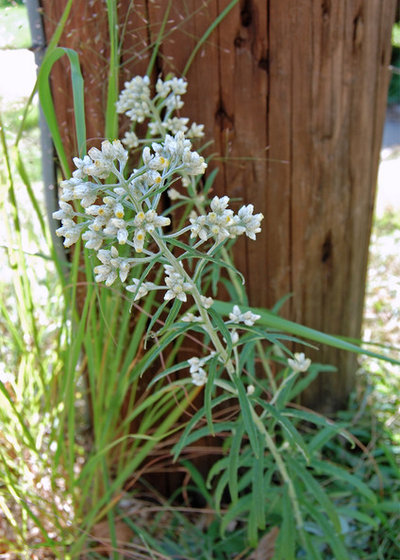 Botanical name: Pseudognaphalium obtusifolium
Botanical name: Pseudognaphalium obtusifolium (formerly
Gnaphalium obtusifolium)
Common names: Rabbit tobacco, sweet everlasting, tall cudweed, cat-foot, old-field balsam
Origin: Native to the entire Eastern Seaboard and west to Texas and Minnesota
Where it will grow: Found in old fields, woodland edges and poor sandy soils, being well-adapted to grow in disturbed sites. As a native annual, it overwinters as a seed. Based on its native distribution, the seed is winter-hardy to at least minus 35 degrees Fahrenheit, or minus 37 degrees Celsius (USDA Zone 3; find your zone)
Water requirement: Medium to dry, well-drained soil
Light requirement: Full sun to partial shade
Mature size: Typically 2 to 3 feet tall and about 1 foot wide; somewhat shorter in shadier locations
Shown: A plant started indoors and transplanted to a parking strip with dry, compacted soil
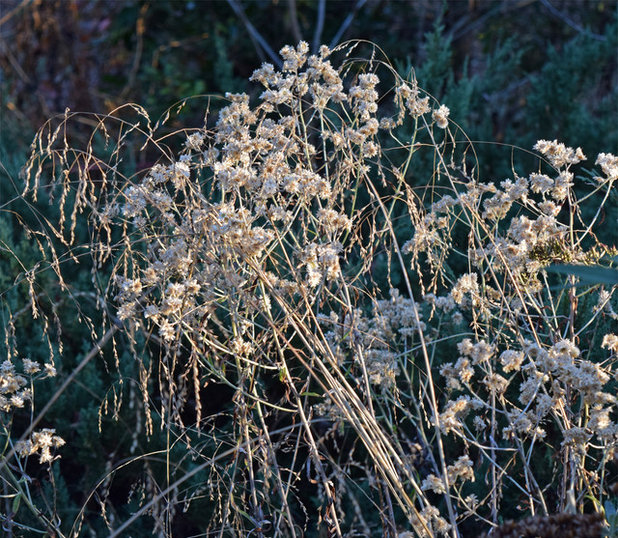 Benefits and tolerances:
Benefits and tolerances: Long-lasting flowers and attractive spent blooms; deer don’t bother this plant during the growing season, but are known to browse on the dried foliage
Seasonal interest: Blooms from July through October; spent seed heads add interest into January (and can even be brought inside for dried flower arrangements)
When to plant: Seeds can be started indoors under lights after two months of cold, moist stratification. In fall to midwinter, sowing directly into open soil in the desired location is an easier way to get these plants established. Mail-order nurseries may offer small potted plants in spring.
Shown: Rabbit tobacco in late fall, with the spent flower heads catching the afternoon light
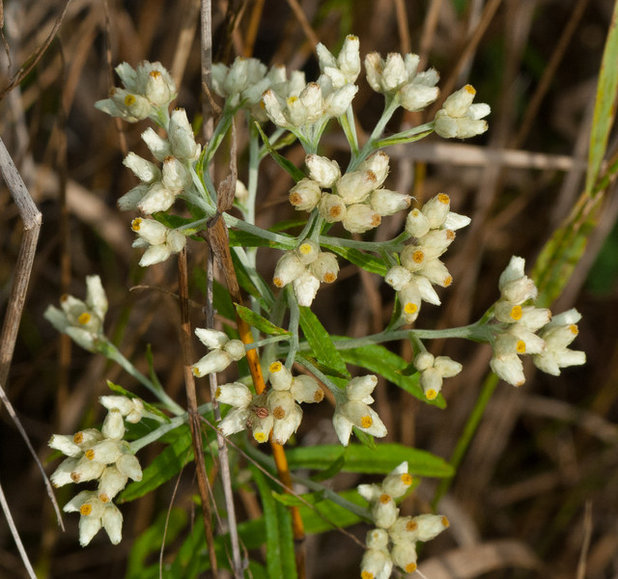 Distinguishing traits.
Distinguishing traits. The bright white flowers you see are actually bracts wrapped tightly around small yellow disk flowers. These bracts remain attractive through the fall. After the fluffy seeds are released, the remaining outer bracts stay attached and catch the low winter light.
The narrow leaves are 1 inch to 2 inches long, with blunt tips. The undersides of the leaves and the stems are covered with fine white hairs that highlight those parts in the sunlight. When bruised, the foliage emits a balsam-like scent, which some call a maple sugar scent. It reminds me of a mild curry.
Shown: The tightly packed yellow disk flowers surrounded by the white bracts. The narrow leaves have blunt tips, hence the “
obtusifolium” (“obtuse leaves”) part of the botanical name.
Photo by Joshua Mayer
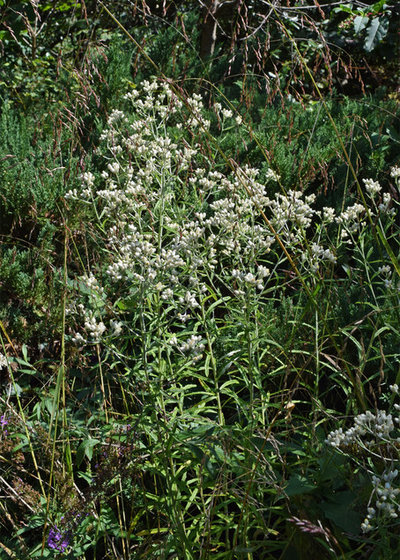 How to use it.
How to use it. The individual flowers are small, but the bright white clusters stand out against darker foliage backgrounds, as does the light gray-green foliage.
As an annual, it dies completely each winter and grows anew in the spring from dispersed seed. Native annuals tend to move around the garden from year to year, coming up where conditions are favorable. To encourage rabbit tobacco to grow, leave some garden areas open to the light with open contact to bare soil.
Native American tribes used its leaves and roots as an herbal remedy for a variety of ailments, including fevers and sore throats.
Shown: Standing out in front of the dark foliage of a common juniper bush
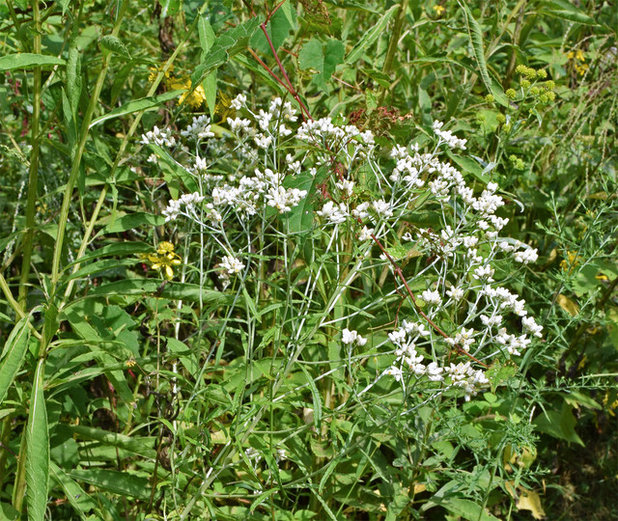 Planting notes.
Planting notes. The availability of live plants for sale is limited, so growing them from seed may be the best option. Several native-plant nurseries sell the seeds (often listed under the older name
Gnaphalium obtusifolium).
The seeds need a period of cold, moist storage before they will germinate. This can be done by sowing outdoors from fall until midwinter. If sowing indoors, store seeds in moist, not wet, fine sand for two months in a refrigerator at 35 to 40 degrees Fahrenheit, or 1.7 to 4.4 degrees Celsius, before sowing into a soilless potting mix. I have also sown seeds directly into a premoistened seed-starting mix and placed that in a refrigerator for two months before putting the whole tray under lights. I’ve had trouble successfully transplanting seedlings into the garden; however, naturally reseeded plants do quite well. It may be that the young root system is very fragile.
The seeds of rabbit tobacco are tiny, about 0.5 millimeter long. When working with tiny seeds, it is often helpful to blend them with some fine sand. This way you can see where the seed falls as you spread it. Whether you sow indoors or out, the seeds need light to germinate. They should be scattered over the surface of the soil and pressed into contact, but not buried.
Rabbit tobacco grows primarily as an annual. In some cases it may behave as a biennial, growing a low rosette of fuzzy leaves the first growing season and then blooming in the second season. The flowers are insect-pollinated, most commonly by short-tongued bees, flies and wasps. The plant also serves as a larval host for the American lady (
Vanessa virginiensis) and painted lady (
V. cardui) butterflies.
Shown: A clump coming up in a recently cleared thicket that is being managed as a meadow. It is right on the edge of a mowed path. The fine hairs on the stems catch the light and make them look nearly white.





